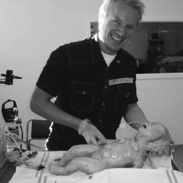Research Projects

My research lies within the fields of medical education, simulation and technology-enhanced learning. Currently I am mainly involved in the following projects:
-
•Trauma team training using gamification and virtual reality technologies
-
•Exploring virtual patients as support for training trauma team leaders’ decision making in complex trauma cases - with Natalia Stathakarou
-
•The educational utility of live tissue training in the acquisition and maintenance of competence in the management of complex (combat-related) traumatic injuries - with Cara S. Swain
-
•Teamwork performance during red codes at two emergency departments in Stockholm
-
•Using a contextual activity sampling approach (experience sampling) to investigate nursing students’ experiences of learning activities during their clinical placements
-
•LEAP - Learning Anatomy and Physiology with visualization tables
-
•ACoRD - advancing co-creation RLOs to digitalize healthcare curricula
-
•CEPEH - Chatbots Enhance personalised European Healthcare Curricula
-
•ENTICE - Evaluating Novel Tangible and Intangible Co-creative Experiential medical education
-
•REHIN - Refugees' Health Integration
-
•dCOG - How can eHealth transform patient – professional interaction and collaboration in chronic care management? (a distributed cognition perspective)
-
•Communication, coping and social networking among infertile women and men - with Taina Sormunen
-
•Evaluation of the proficiency test for dentists with education outside - with Jesper Dalum
-
•Using Web-based Education to Improve Diabetic Patients’ Self-care Management - with Javad Jafari
-
•Capturing challenges in clinical practice and preparing students through learning from authentic challenges in Room of Horror training - with Marit Vassbotten Olsen
-
•Research on Simulation in Radiography Education with Mona Vestbøstad & Nina Rydland Olsen
Previous Research Projects
-
•AI and the future of military medicine
-
•KNORK - Promoting Knowledge Work Practices in Education. This EC-funded project provides and investigates pedagogical approaches promoting “trialogical” learning which suggests principles for sophisticated collaborative knowledge creation practices.
-
•Studies on the quality of debriefings and feedback during simulation-based training in medicine/healthcare.
-
•A study on the role of representational artifacts and actions in interaction design: Sketching as an embodied practice (DEKAL II) financed by the the Swedish Research Council / educational research.
-
•Contextual Activity Sampling System (CASS) - using mobile devices to study learning experiences in context.
-
•The Knowledge-Practices Laboratory (KP-Lab) was financed by the EC 2006-2011. The project aimed at supporting learning by developing ”knowledge practices”, by changing and developing the working practices of students and professionals in how they develop knowledge. At Karolinska Institutet we studied learning in medicine, in mainly two sub-projects. One concerned simulation-based training of medical teams and the development of debriefing sessions which are a part of the simulation courses. It also concerned the development of conceptual and digital tools for analyzing video data used during the courses with the purpose of supporting the medical teams. The other sub-project concerned collection of data from interprofessional student team working at clinical training wards. We developed the Contextual Activity Sampling System (CASS) which is a novel methodology and tools based on mobile technology for collecting contextualized data from students five times a day when they are working at the clinic.
-
•DEKAL Shared representations and collaborative learning of interaction design (Delade representationer och kollaborativt lärande av interaktionsdesign). Financed by the Swedish Research Council 2004-2006. A main issue concerned the roles of shared representations in the context of collaborative learning of interaction design and how professional interaction designers sketch interaction. A particular interest was on the use of design patterns on the quality of collaborative design work.
-
•The e-Meeting Platform project at the Royal Institute of Technology financed by the EC. The purpose was to create web-based tools for electronic meetings - mainly for distance-collaboration but also for supporting face-to-face meetings - and resulted in a commercial product. 2004-2006
-
•"Ways of fostering active learning and implementing computer technology in medical and engineering education" (Lärande och undervisning på högskolan - vägar till ett aktivt lärande och användande av datorteknik i medicinsk och teknisk utbildning) financed by the Swedish Research Council at Karolinska Institutet. 2003-2005. The project investigated learning and teaching in higher education and medicine at medical schools across Sweden and also in Finland and developed the Med Nord instrument.
-
•The APE and PADLR projects were parts of the Wallenberg Global Learning Network at The Royal Institute of Technology and concerned software to support learning among university level mathematics students. 2001 – 2002.
-
•Hypermedia and Communication for Active Learning (HYCAL) was financed by the Swedish
-
•National Agency for Higher Education and concerned the design of training environments for students learning about conceptual modeling based on the cognitive apprenticeship model. 1998-2001.
-
•Scenario based Training Environments for learning Protein Purification (STEPP) which concerned the development of an interactive multimedia training program based on ideas about refining language use and was based on dialogues with simulated customers. Financed by the Swedish National Board for Industrial and Technological Development (NUTEK). 1997-2000
-
•Plan- and User Sensitive Help (PUSH) was a prototype for a user and context adaptive help assistant for a development method for telecommunication applications. Financed by the Swedish National Board for Industrial and Technological Development (NUTEK) 1993-1996
-
•AUGMENT (Augmentation of expertise; Model refinements and Model shifts) had the goal of studying how expertise in particular domains (in particular in physics) could be augmented in terms of refinements of and shifts between explanatory models of the domains. Financed by the Swedish Research Council. 1993-1997
-
•INTUITIVE had the objective of creating a graphical language used in interfaces to relational databases and was financed by the EC 1992-1994
